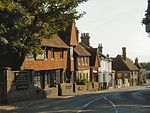Anderitum

Anderitum (also Anderida or Anderidos) was a Saxon Shore fort in the Roman province of Britannia. The ruins adjoin the west end of the village of Pevensey in East Sussex, England. The fort was built in the 290s and was abandoned after it was sacked in 471 (491 according to the disputed Anglo-Saxon Chronicles). It was re-inhabited by Saxons and in the 11th century the Normans built a castle within the east end of the fort. The site decayed to become the archetypal ruinous medieval castle, Pevensey Castle, which is surrounded by a small moat, large green, and unusually substantial Roman defensive walls on three sides. During the Second World War, the Roman fort and medieval castle were adapted for modern warfare, and pillboxes were built into the Roman walls.
Excerpt from the Wikipedia article Anderitum (License: CC BY-SA 3.0, Authors, Images).Anderitum
High Street, Wealden Pevensey
Geographical coordinates (GPS) Address External links Nearby Places Show on map
Geographical coordinates (GPS)
| Latitude | Longitude |
|---|---|
| N 50.8188 ° | E 0.3338 ° |
Address
Pevensey Roman Fort
High Street
BN24 5JP Wealden, Pevensey
England, United Kingdom
Open on Google Maps











